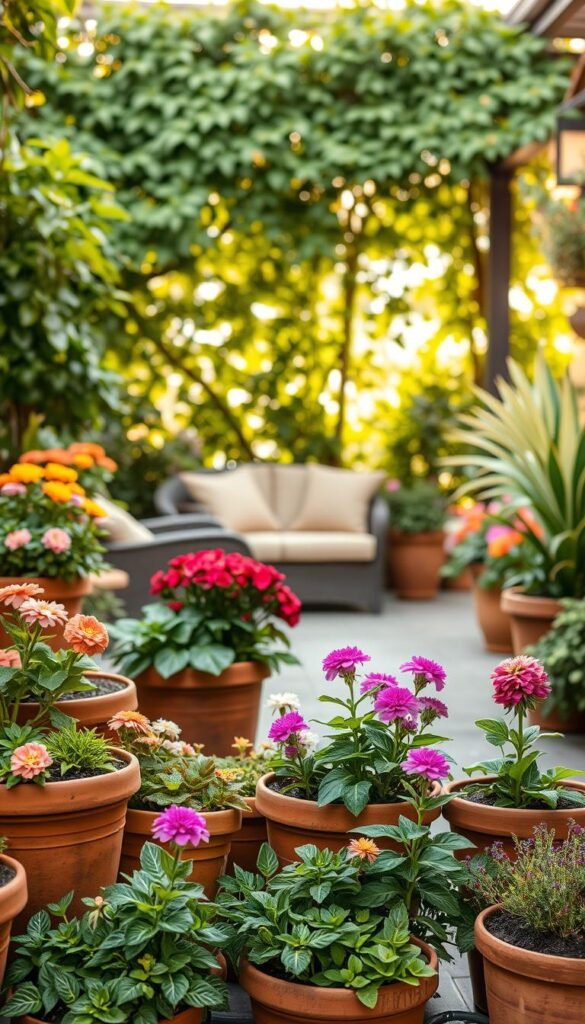Potted arrangements offer endless ways to refresh your patio, balcony, or porch. Unlike fixed flower beds, these movable displays let you experiment with colors and textures while adapting to sunlight changes or seasonal shifts. Nearly 7 in 10 homeowners now use these flexible setups to add personality to their yards.
Strategically placed greenery can turn bland corners into eye-catching focal points. You might frame a seating area with tall grasses or use cascading blooms to soften hardscapes. For inspiration, explore flower varieties that brighten your space while requiring minimal upkeep.
These living decorations work beautifully with existing furniture and architectural details. A well-chosen planter draws attention to your front entryway, while herb clusters near the grill make outdoor cooking more convenient. The secret lies in selecting plants that thrive in your local climate and light conditions.
With thoughtful placement, you can create intimate conversation nooks or screen less attractive views. Best of all, changes are simple – just rearrange your pots whenever you want a fresh look without digging up your yard.
Understanding the Basics of Container Garden Design
Transform any space into a vibrant oasis using portable greenery. Whether you’re sprucing up a fire escape or framing a front door, movable arrangements let you test layouts before committing. Urban dwellers and suburban homeowners alike love how these living accents solve space challenges while boosting curb appeal.
Why Portable Plantings Work
No yard? No problem. These setups thrive on balconies and windowsills. You can shift pots to chase sunlight or protect delicate blooms from harsh weather. Need seasonal updates? Just swap out annuals instead of replanting entire beds.
“Quality potting mix with compost gives roots room to breathe while holding nutrients better than dirt from your yard.”
Picking Your Plant Partners
Material choice affects maintenance. Consider this comparison when selecting vessels:
| Material | Water Retention | Best For |
|---|---|---|
| Terra Cotta | High | Moisture-loving plants |
| Metal | Low | Drought-tolerant varieties |
| Plastic | Medium | Beginner-friendly setups |
Pair your containers with fast-draining soil blends. For patio arrangements, use trailing ivy to soften edges or tall grasses for privacy screens. Remember – mismatched pots add character when grouped intentionally.
Start small with herbs or succulents if you’re new to plant care. Their resilience makes them perfect practice partners while still delivering visual impact. Before long, you’ll be creating eye-catching displays that evolve with your taste and the seasons.
Designing Outdoor Living Areas that Enhance Your Garden
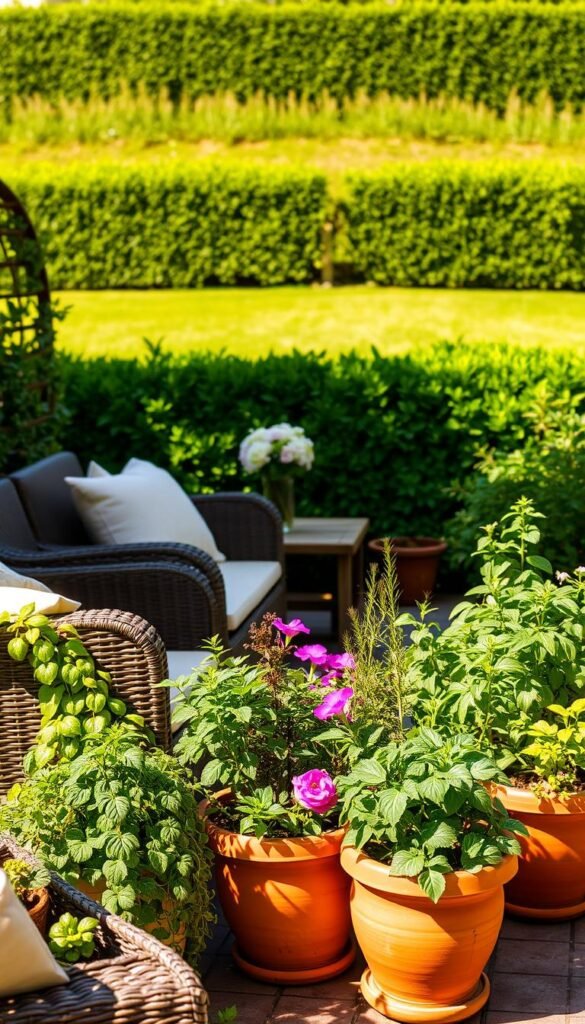
Your patio becomes an extension of your home when framed with lush greenery. Position container plants near seating arrangements to create cozy nooks that invite relaxation. Tall grasses in modern planters offer privacy, while fragrant herbs like lavender add sensory appeal.
Creating Inviting Seating Areas
Arrange pots in clusters around benches or chairs to define conversation zones. Mix heights for visual interest – try this simple formula:
| Container Size | Placement | Plant Type |
|---|---|---|
| Large (24″+) | Corners | Ornamental grasses |
| Medium (12-18″) | Tabletops | Trailing petunias |
| Small ( | Side tables | Succulent varieties |
Leave walking space between containers for easy movement. “Groupings of three pots create balanced focal points,” suggests landscape designer Mara Hoffman.
Integrating Functional Accents
Use vertical elements to maximize limited areas. A trellis with climbing clematis turns blank walls into living art. Rotate seasonal blooms in planters flanking your front door – this simple switch updates curb appeal instantly.
Stagger plant stands near outdoor kitchens to keep herbs within reach. The right combinations make your space feel intentional yet effortless. Remember to leave room for growth – both your plants and your design ideas!
Mixing Colors, Textures, and Foliage for Visual Appeal
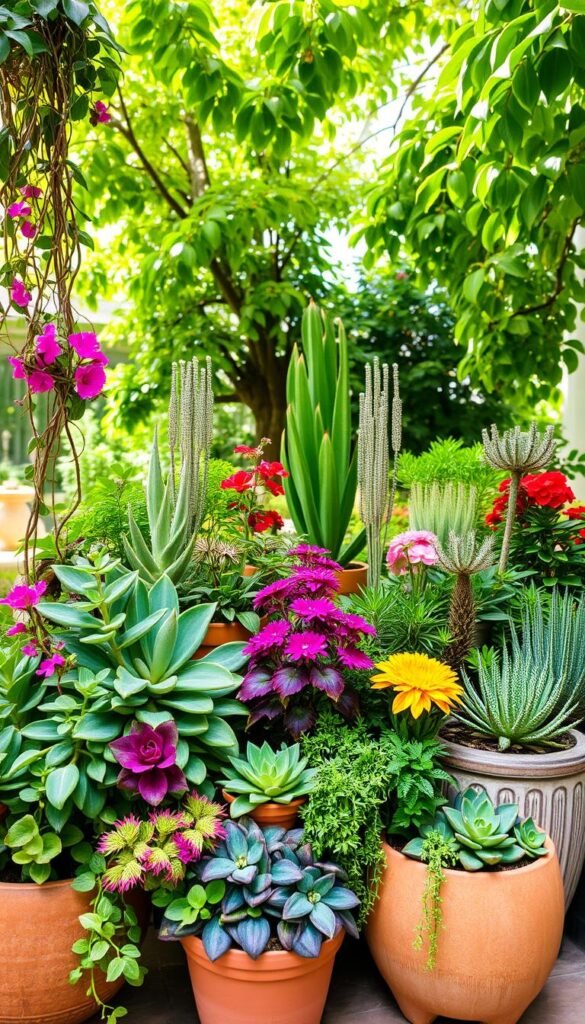
Crafting eye-catching displays starts with smart pairings of blooms and leaves. You’ll love how contrasting shapes and hues transform ordinary pots into living art. Three out of five gardening enthusiasts report higher satisfaction when focusing on foliage variety alongside flowers.
Building Balanced Plant Combinations
Start with thriller plants like spiky dracaena as vertical anchors. Add mounding petunias and trailing ivy to fill space naturally. Evergreens keep arrangements lively during bloom gaps.
Match growth speeds to prevent overcrowding. Fast-growing coleus pairs well with slow-spreading sedum. For low-maintenance setups, combine drought-tolerant succulents with ornamental grasses.
Strategic Color Coordination
Warm reds and oranges energize dining areas, while blues soothe reading nooks. Try this simple guide:
| Color Group | Mood | Plant Examples |
|---|---|---|
| Warm tones | Energetic | Marigolds, Celosia |
| Cool tones | Calming | Lobelia, Ageratum |
| Neutrals | Balancing | Dusty Miller, Artemisia |
Repeat key hues across multiple pots to unify your space. Silver-leaved plants bridge bold colors beautifully. Remember – texture contrast matters as much as color harmony for depth.
Creative Container Arrangements for Every Space
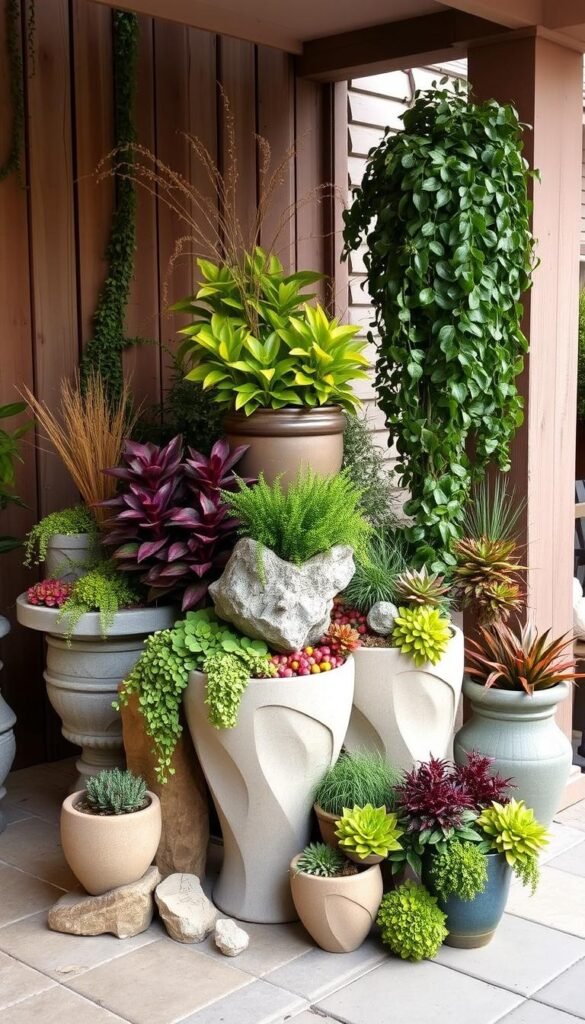
Turn blank walls into living masterpieces with clever setups that work in tight spots. Vertical solutions and bold focal points let you maximize small patios or sprawling decks without overwhelming the area.
Vertical Gardens and Window Boxes
Hanging baskets and tiered stands add layers of greenery where floor space is limited. Herbs like basil and thyme thrive in these setups, moving seamlessly from outdoor cooking zones to sunny kitchen windowsills.
Window boxes filled with trailing ivy or coleus soften harsh architectural lines. They frame views while adding bursts of color to plain exteriors. Try this comparison for vertical success:
| Type | Best Plants | Placement |
|---|---|---|
| Hanging Baskets | Strawberries, Petunias | Overhead beams |
| Window Boxes | Ferns, Begonias | Under windows |
| Tiered Stands | Succulents, Herbs | Balcony corners |
Planters as Focal Points
Oversized planters make bold statements. A single creeping Jenny spilling over a garden obelisk draws eyes to entryways. Double basket designs stack complementary blooms for instant visual depth.
Mix textures in individual pots – pair spiky dracaena with velvety lamb’s ear. For more creative gardening ideas, position statement pieces where guests naturally gather, like fire pits or dining areas.
Seasonal Tips for Container Planting and Maintenance
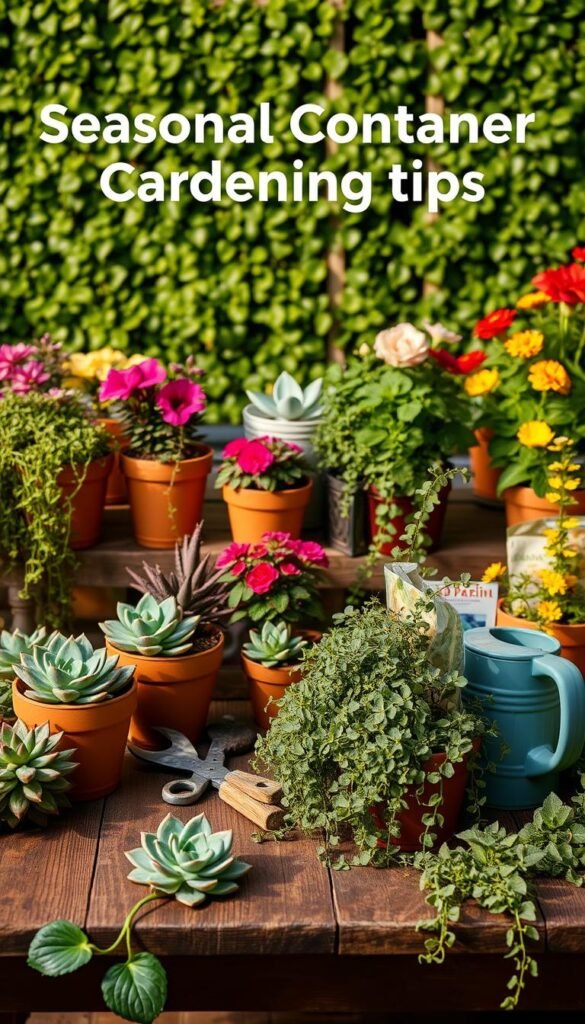
Keep your potted displays thriving year-round with smart seasonal strategies. Timing your plant swaps and soil care ensures vibrant growth through temperature shifts. Start by choosing varieties that handle your region’s weather patterns – this simple step reduces maintenance headaches later.
Spring and Summer Trends
When spring arrives, pair heat-loving petunias with backup plants like sweet potato vine. These fast growers fill gaps when lamb’s ear or other sensitive varieties wilt in summer heat. Pro gardeners recommend refreshing soil every 12 weeks to maintain nutrient levels during peak growing months.
For continuous color, try this rotation plan:
- April-May: Cool-weather pansies
- June-August: Drought-tolerant lantana
- September: Transition to ornamental kale
Discover more seasonal container gardens that adapt as temperatures rise. Always leave space for sprawling plants to expand naturally.
Adapting to Changing Seasons
As autumn approaches, replace fading annuals with cold-hardy greens like Swiss chard. Move pots to south-facing walls for warmth retention. When frost threatens, wrap perennial containers in burlap or move them to sheltered spots.
Winter prep involves three key steps:
- Remove dead foliage to prevent mold
- Mix fresh compost into soil
- Elevate pots off frozen ground
You’ll make sure your gardening efforts pay off by planning these transitions early. Track seasonal changes using a simple calendar reminder – your future self will thank you when spring planting begins!
Expert Care Techniques for Long-Lasting Gardens
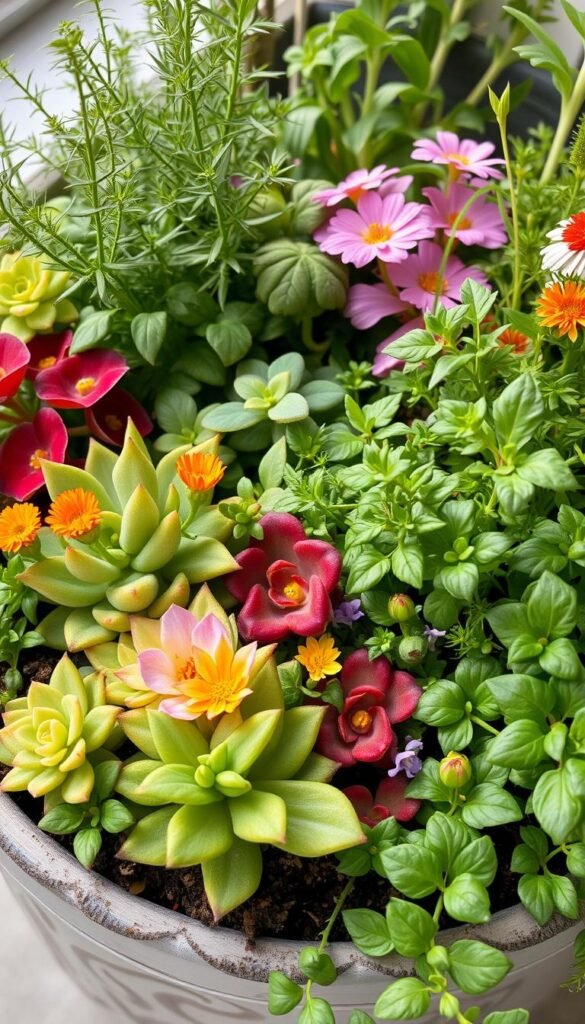
Keeping your potted greenery thriving requires smart routines. Whether you’re nurturing herbs or flowering annuals, three factors make the difference: consistent watering, timely pruning, and nutrient-rich soil.
Watering and Pruning Strategies
Your plants crave moisture balance. Check soil daily by sticking your finger 1-2 inches deep – water only when it feels dry. Consider these options for efficient hydration:
| Method | Best For | Frequency |
|---|---|---|
| Drip irrigation | Large collections | Daily |
| Watering wand | Precise control | Every 2-3 days |
| Self-watering pots | Busy schedules | Weekly refills |
Prune strategically to boost growth. Remove yellow leaves at the stem base using clean shears. For flowers like petunias, pinch off faded blooms just below the seed head. This “deadheading” trick tells plants to make more flowers instead of seeds.
“Sharp tools prevent disease spread – disinfect blades with rubbing alcohol between plants,” advises master gardener Lena Torres.
Pair these techniques with quality soil from choosing the right containers. Refresh potting mix every spring to replenish nutrients. A monthly dose of liquid fertilizer keeps foliage vibrant during peak growing months.
Combining Container Garden Design with Outdoor Living Areas
Your planters’ location shapes your garden’s success more than you might think. Start by mapping sunlight patterns across your space – most thriving arrangements need six hours of direct light daily. South-facing spots suit sun-loving herbs, while shaded nooks work for ferns.
Practical Planning and Placement
Measure your available area before choosing containers. Oversized planters overwhelm small patios, while tiny pots get lost on spacious decks. Track light shifts using a phone app or simple notes. Pro tip: Use self-watering pots in sunny zones to prevent soil from drying too fast.
Mix materials wisely – metal planters suit modern setups, while rustic clay complements cottage styles. Always check drainage holes to protect roots during storms. For small-space solutions, try vertical stands that maximize air flow and visual impact.
Recommendations from Gardening Experts
“Match plant sizes to container depth,” suggests Utah’s Cactus & Tropicals team. “Shallow-rooted succulents thrive in low bowls, while tomatoes need deeper homes.” They recommend refreshing soil yearly and using slow-release fertilizers for busy gardeners.
Secure lightweight pots with adhesive strips during windy seasons. Foldable stools or wall shelves create flexible staging areas for rearranging displays. Remember – even expert-designed spaces evolve. Your setup should grow with your tastes and lifestyle!

